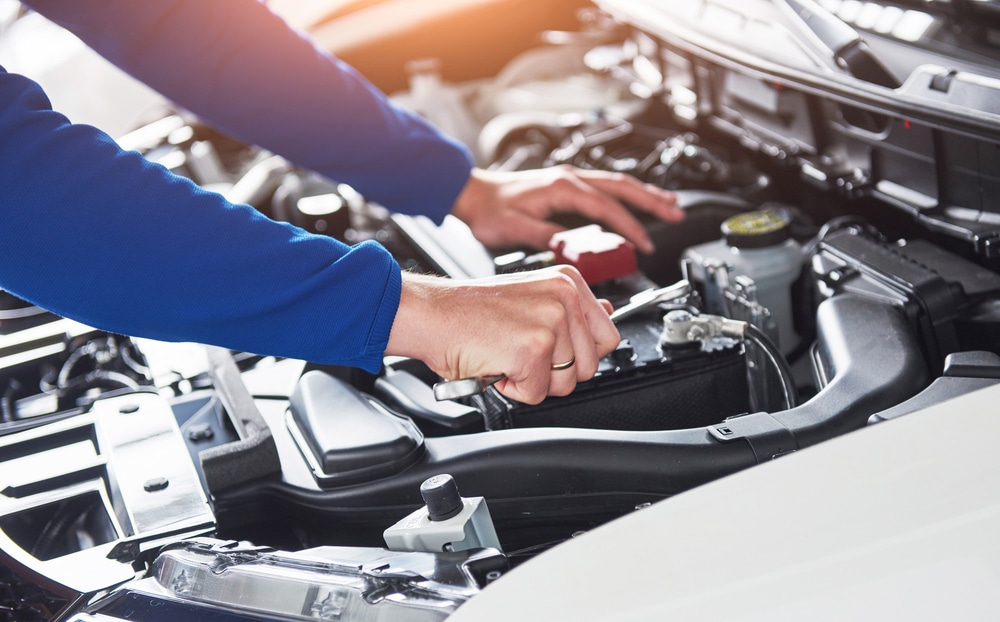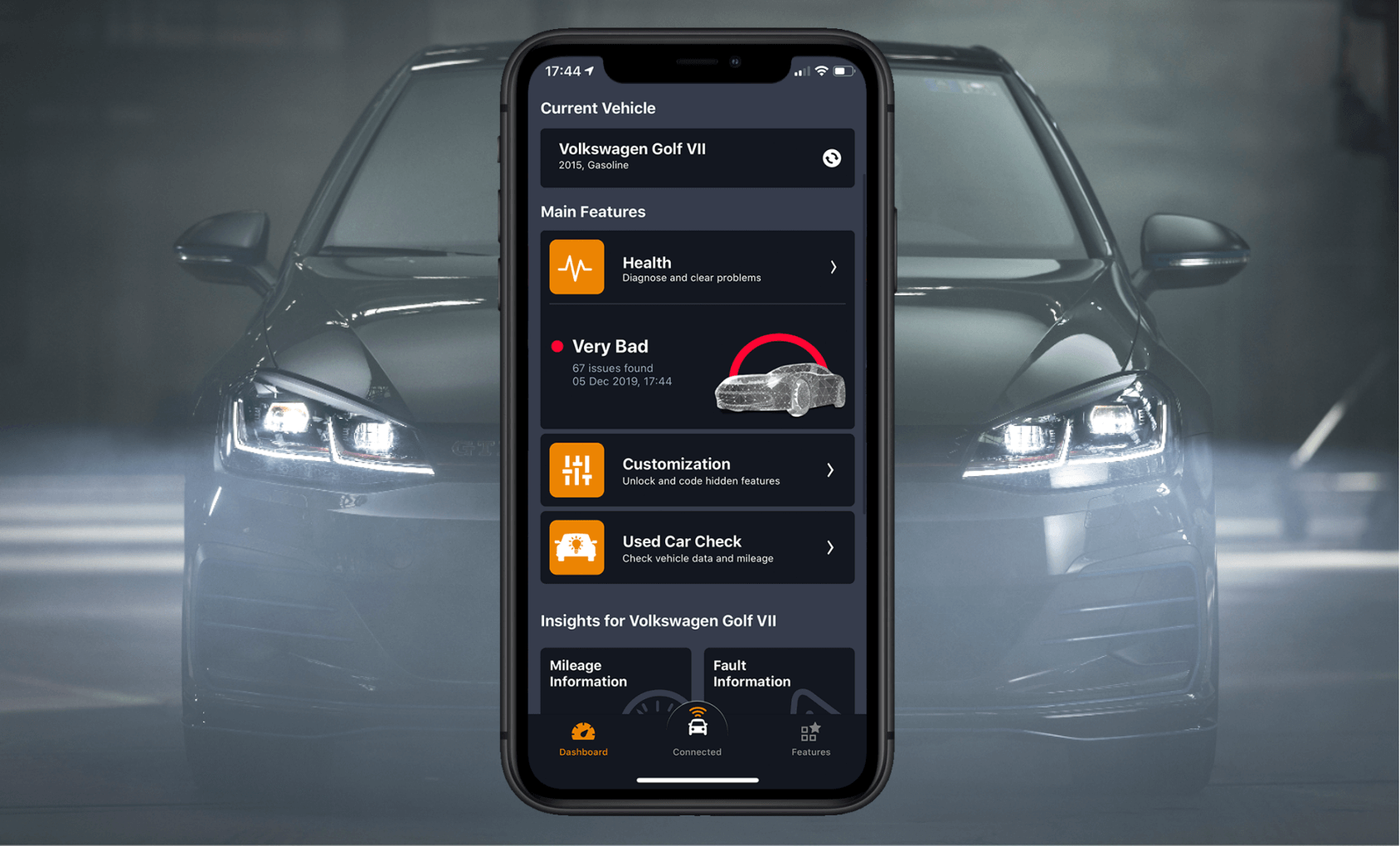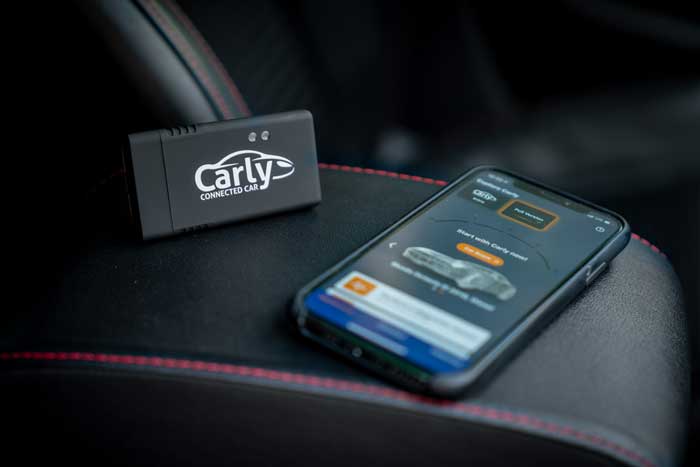Nowadays, cars are nothing more than mobile computers. Your PC certainly doesn’t always run smoothly, and the same applies to your vehicle. Moderns cars have up to 80 control units built-in which regulate all the electronic parts and processes. When your car presents problems, they are stored in the form of OBD2 codes which can then be read out to understand your car’s health.
So, how can you read out your car? There are several tools and possibilities to do this. This first option is going to a mechanics garage and have the codes read out by car technicians. On the other hand, a quicker and affordable alternative is to read out the codes by yourself! To do this all you will need is an OBD2 scanner that can read out the codes for you in seconds.
If you use the Carly OBD scanner, you just need to plug it into your car’s OBD port and open the Carly app on your phone to see all the OBD2 codes. It’s that easy! Additionally, with the OBD2 scanner, you will get more insights about your car’s health, and even depending on your car model you can code your car and carry your own maintenance!
Let’s start off by understanding how to take better care of your car by reading out OBD2 codes. We will explain to you what are error codes, how to read them out, and the best practices to do this!
Like having your own mechanic!
What are OBD2 codes?
Problems and malfunctions can occur in your car from time to time. In many cases, the control units can fix them on their own. Every malfunction is recorded in the form of an OBD2 code, which is also called an error or fault code.
Problems that cannot be fixed immediately by the car’s control units are often indicated to the driver in the form of indicator lights on the dashboard. Depending on the vehicle model, a fast flashing light can also mean that it is a very serious fault. In such a case, you should immediately turn off the engine to prevent further damage.
Moreover, all codes – of which there are about 10,000 – have been standardized by the SAE J2012 and ISO 15031-6 standards. There are different types of OBD2 codes and most of them always follow the same logic in their structure. Each error code consists of five digits, where each digit stands for something different.
What does the first digit of an OBD2 code mean?
The first digit indicates the area of the car where the error comes from. These letters represent each area:
- P (Powertrain) = Engine and transmission.
- C (Chassis) = Chassis
- B (Body) = Body
- U (User Network) = Network
The second digit of an error code
The second digit tells you whether it is a standardized or manufacturer-specific code:
- 0 = Standard code
- 1 = Manufacturer specific code
The third digit of an error code
The third digit represents the subsystem that related to the code.
- 0, 1, and 2: air and fuel metering control.
- 3: Ignition system
- 4: Additional emission control
- 5: Engine idle control
- 6: on-board computer and auxiliary outputs
- 7, 8, and 9: Transmission control system
- A, B, and C: Hybrid drive
Fourth and fifth digits of an error code
The last two digits (00-99) indicate the actual error.
However, don’t worry about learning all of these error codes. The app (or the workshop) will explain the errors to you in detail.
OBD2 List of Codes: Looking at some examples!
If you are dealing with manufacturer-specific faults, only specialized workshops and apps can help. Here are some examples of what error codes look like and what they mean. The example also refers to P0xxx:
- P0070: Outdoor temperature sensor – There is a malfunction in the circuit.
- P0071: Outdoor temperature sensor – There is a range of function error
- P0072: Outdoor temperature sensor – The input signal of the sensor is too low
- P0073: Outdoor temperature sensor – Sensor input signal is too high
- P0092: Fuel metering valve – There is a short-circuit on the battery positive.
- P0118: Coolant temperature sensor – The input signal is too high
- P0148: Wrong fuel delivery rate
- P0195: Engine oil temperature sensor – There is a malfunction in the circuit
- P0217: An engine overheat has been measured
- P0218: A transmission overheating was measured
- P0297: An impermissible vehicle speed was detected
- P0402: Exhaust gas recirculation – An excessive flow rate was detected
- P0613: Transmission control unit – A computer error has occurred
Which OBD2 codes are recorded?
Errors can occur once or repeatedly in different areas of your car. If the control unit of your car can correct the error itself, it is registered, but the driver is not necessarily informed. However, there are errors that cannot be corrected by the control units since the car needs manual repair.
A simple example of an OBD2 code that cannot be solved by the car itself is the oil level. If the oil level falls below a certain mark, the driver receives a warning and the error is recorded. The same way it works for the brake fluid or the wiper water.
Nevertheless, there are more complex errors that aren’t notified immediately to the driver but that will need to be addressed eventually. For instance, many electronics of the car are exposed to strong influences such as high temperatures, wetness, vibrations, wear, corrosion, so eventually, a part may need replacement.
Therefore, it is recommended to read your car’s errors regularly to learn more about its health state. You might be wondering if many errors occur in your car? And if so, which errors occur? And how often? With the help of an OBD2 scanner and its mobile app, you can easily get all the answers to your questions.
Having your own OBD2 scanner allows you to read out your car’s codes as often as you want without having to pay for it every time – which is not the case if you go to a repair shop.
In the case of using the Carly scanner and app, besides reading and deleting error codes, you can even control back your car! But let’s dive into that later.
How do control units (or ECUs) work?

ECUs are practically small computers that are often equipped with their own chips (even up to quad-core). They control all the vehicle’s electronic systems and work according to the EVA principle: input–processing– output.
Furthermore, ECUs receive information (input) via sensors, e.g. about the amount of gasoline injected. This value is compared with a target value. If there is a deviation between the target value and the actual value, the control unit takes corrective action.
For every case, a fault code is generated and stored in the car’s system. If the control unit cannot correct the error itself, a warning light is activated in most cases to inform the driver about the error.
Moreover, all ECUs are connected via a data highway (CAN bus) and can be addressed via the so-called OBD interface using an adapter.
What is the OBD interface?
OBD means on-board diagnosis and was originally developed only for exhaust gas-relevant systems, in order to ensure environmentally compatible exhaust gas values. All the important data about the exhaust gas was stored in the car’s system so that car technicians could see where possible problems were.
Now, the OBD allows the storage of the car’s health data throughout its entire lifetime in order to know the state of your car. In very concrete terms, OBD-2 has the following tasks:
- Continuous monitoring of all exhaust-related components, such as the lambda sensor or the mass airflow sensor.
- Recording and reporting of all emission increases (error codes)
- Protection of the catalytic converter
- Saving data and errors in the event of faults occurring
- Provision of an interface for reading out stored and real-time operating data
- Display of errors via indicator lights
Nowadays, through the current OBD2 standard (which has been installed in all new vehicles since 2004), your vehicle’s data can be easily accessed using a mobile app.
What is OBD-3?
In the USA, work is currently underway on the new OBD-3 standard. With OBD-2, all emission-related values are recorded, warnings are displayed and errors are recorded. However, with this standard, if the driver decides not to fix a fault code, they can drive around with an “environmental foul” until their next emissions test.
On the other hand, with OBD-3, this would no longer be possible, since errors and bad values are transmitted directly to the responsible authority via SIM or satellite. Only if the driver has the affected systems repaired within a certain period of time they can avoid the corresponding fine.
How does reading out the OBD2 codes with an app work?

Should you choose the Carly app, it’s all very simple. You simply order an OBD-2 adapter on the website, which you plug into the socket in the vehicle’s interior (usually on the steering column) after receiving it. The app connects to the adapter via Bluetooth and thus to the vehicle. All data can then be read and processed.
In four very simple steps, you can read out, analyze and also delete the error codes.
- Order the OBD2 scanner (called, Carly Universal Adapter) on our website.
- Download the Carly app from the App Store or Google Play.
- Plug the adapter into the OBD socket of your vehicle.
- Open the Carly app (it automatically connects to the adapter) and your done!
This is all very simple and very understandable even for beginners.
Firstly, the error codes will be read out, which might take up to 20 minutes the first time. Afterward, the errors will be displayed with an explanation and can be saved in the app.
Usually, you go here at the end and delete the fault memory of the vehicle. With regular readouts, the whole thing is much faster, of course, because then usually only a few new codes have to be read.
You can even use the free version of the Carly app to read out the standard codes. Only if you want to use premium functions you can get the app license.
Why is it important to read the OBD2 codes regularly?
Reading out the error codes regularly is important in order to detect emerging problems in good time and avoid potentially expensive repairs.
If an error appears over and over again, there must be something wrong with the system. Before this system fails, you can have it briefly checked by a specialist in a workshop.
Furthermore, problems are often interrelated. With an appropriate diagnostics app, you can see all of your car’s parts that are connected to a problem.
Let’s assume that there are repeated errors in the lambda sensor (this is responsible for the correct ratio of combustion air to fuel). If it is defective, this can lead to extremely high fuel consumption and higher CO2 emissions. In parallel, you could also be getting error messages for the mass airflow sensor. This could suggest that actually, the lambda sensor is perfectly fine, but there may be a physical hole in the intake tract for the air, caused by corrosion. Repairing this hole would be much cheaper than having to replace the lambda sensor (which is, after all, perfectly functional even though it generates error messages).
How to clear error codes?
After you have read and fixed the error codes, you can also delete them from the vehicle since they have been solved.
However, let’s say that in January an error of the transmission is displayed so you delete the code. Then in February you run the diagnostics on your app, the same error appears again and you proceed to delete it again. If this error occurs again in March, you should take a closer look since it might need repair.
However, many errors also delete themselves from the memory at regular intervals because they are not considered important and perhaps only occurred once because it was particularly hot or cold on that day.
Is it possible to perform a service reset?
During the readout, you will also get the data of the maintenance (services). All necessary regular maintenance is logged here.
But now comes the tricky part. Let’s say the oil change reminder lights up on your car and your Carly app, so you change the oil yourself.
Unfortunately, it will not be automatically detected by your car and you will have to reset the service manually. If you have the Carly app, this is no problem and can be done quickly. Otherwise, you would only have to drive to a garage. This small but nice feature is good for the wallet.
Will the car never have to go to a workshop again?
Now that would be a dream. But unfortunately, occasional visits to a workshop are inevitable. Major maintenance or repairs certainly have to be done by a professional.
Sometimes an OBD2 code can be determined on our own, but the problem may be in a completely different area that is somehow related. Sometimes it’s just low battery voltage that causes a fault but you have to know how a car works in order to understand all of the parts that are involved.
However, reading the trouble codes will help you track down many minor problems and take care of them yourself. It will give you a better overall feeling about the condition of your car. Just because a warning light is on, you now don’t have to rush to the repair shop. You can first take a look yourself and save your time and money.
What else can you do with Carly?

If you use the Carly app to read the OBD2 codes, you also get many other functions that you can perform on your car!
Vehicle coding
As said before, a modern vehicle is like a computer. Therefore, you can customize many of the functions and change them to your liking.
For example, you can deactivate the start/stop automatic button, activate a visual signal via the turn signals when closing or opening the car, or have amplified engine sounds transmitted to the interior of the car for a sportier driving experience.
Of course, all functions depend on your car model and manufacturer, but you can usually make dozens or even hundreds of codings and thus fully personalize the car.
Vehicle diagnostics
Reading out OBD2 codes is only one part of the extensive diagnostics that you can perform with the Carly app. By regularly checking all systems, users have been able to save up to 15,000 euros over a 10-year period on unnecessary repairs.
Carly presents you with problems in a clear and color-coded analysis. With “red problems” you know that it is really serious and immediate action is required. The big advantage of the app is the visualization and interpretation of the errors, so you can easily understand them even if you are a beginner.
Carry out maintenance yourself
Carly shows you a step-by-step guide simple of maintenance tasks that you can perform yourself to save money. For example, you can also easily register a new battery yourself, or switch the electronic parking brake from normal mode to service mode.
Checking critical values of the diesel particulate filter is also no problem, as well as requesting regeneration of the filter and tracking the entire process.
Let’s say you bought a used car with automatic transmission and now you want to clear the learning memory of the automatic transmission. After all, the car should behave according to your driving style and learn from it and not from that of the previous owner. With the Carly app, you can simply delete the memory and start all over again.
Used car check
Speaking of used cars … unfortunately, up to 30% of all used vehicles have had the mileage tampered to price them higher. To know if your odometer has been manipulated, Carly has a special function that can help you see the actual mileage of your car.
This is easy to detect since the mileage is not only stored in the speedometer but also in other ECUs that can be examined for manipulation and discrepancies. Detecting mileage manipulation can save you a lot of money and trouble in case of doubt.
Digital Garage
Finally, all collected data can be stored in your Carly app and further analysis can be performed. You can also download reports as PDFs or send them by e-mail (e.g. to a new buyer or a garage).
Now you are fully equipped with OBD2 codes knowledge and with an OBD2 scanner you can always have your car’s health fully under control!
Like having your own mechanic!

